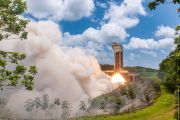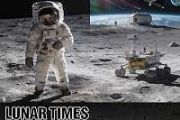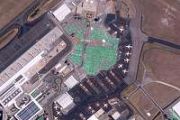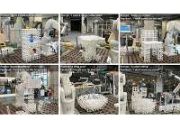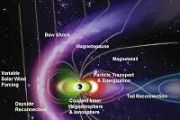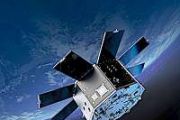
Copernical Team
Moon rocks with unique dust found
 Our Earth's Moon is almost completely covered in dust. Unlike on Earth, this dust is not smoothed by wind and weather, but is sharp-edged and also electrostatically charged. This dust has been studied since the Apollo era at the end of the 1960s. Now, an international research team led by Dr. Ottaviano Rusch from the University of Munster has for the first time discovered anomalous meter-sized r
Our Earth's Moon is almost completely covered in dust. Unlike on Earth, this dust is not smoothed by wind and weather, but is sharp-edged and also electrostatically charged. This dust has been studied since the Apollo era at the end of the 1960s. Now, an international research team led by Dr. Ottaviano Rusch from the University of Munster has for the first time discovered anomalous meter-sized r Lightest black hole or heaviest neutron star? MeerKAT uncovers a mysterious object in Milky Way
 An international team of astronomers have found a new and unknown object in the Milky Way that is heavier than the heaviest neutron stars known and yet simultaneously lighter than the lightest black holes known.
Using the MeerKAT Radio Telescope, astronomers from a number of institutions including The University of Manchester and the Max Planck Institute for Radio Astronomy in Germany foun
An international team of astronomers have found a new and unknown object in the Milky Way that is heavier than the heaviest neutron stars known and yet simultaneously lighter than the lightest black holes known.
Using the MeerKAT Radio Telescope, astronomers from a number of institutions including The University of Manchester and the Max Planck Institute for Radio Astronomy in Germany foun NASA Science, Astrobotic Peregrine Mission One Concludes
 The first flight of NASA's commercial lunar delivery service carrying agency science and technology, as well as other customer payloads intended for the Moon, has come to an end. After 10 days and 13 hours in space, Astrobotic's Peregrine Mission One made a controlled re-entry on Earth over open water in the South Pacific at approximately 4:04 p.m. EST on Jan. 18.
Astrobotic was the first
The first flight of NASA's commercial lunar delivery service carrying agency science and technology, as well as other customer payloads intended for the Moon, has come to an end. After 10 days and 13 hours in space, Astrobotic's Peregrine Mission One made a controlled re-entry on Earth over open water in the South Pacific at approximately 4:04 p.m. EST on Jan. 18.
Astrobotic was the first Viasat Leads Historic UK SBAS Flight Trial, Showcasing Advanced GPS Capabilities
 Viasat, Inc. (NASDAQ: VSAT), a global satellite communications company, has marked a significant milestone in the UK's satellite navigation capabilities by successfully demonstrating the UK Satellite-Based Augmentation System (SBAS) for the first time. This test, conducted from Cranfield Airport using a Saab 340B aircraft from the National Flying Laboratory Centre, has showcased the potential of
Viasat, Inc. (NASDAQ: VSAT), a global satellite communications company, has marked a significant milestone in the UK's satellite navigation capabilities by successfully demonstrating the UK Satellite-Based Augmentation System (SBAS) for the first time. This test, conducted from Cranfield Airport using a Saab 340B aircraft from the National Flying Laboratory Centre, has showcased the potential of Lynk and Telikom initiate Sat2Phone services in Papua New Guinea
 Lynk Global, Inc. (Lynk), a leader in satellite-direct-to-standard-phone (sat2phone) telecommunications, in a landmark collaboration with Telikom Limited (Telikom), has announced the launch of initial Sat2Phone services for subscribers in Papua New Guinea. This innovative partnership is set to significantly improve mobile coverage throughout the country, offering unprecedented connectivity benef
Lynk Global, Inc. (Lynk), a leader in satellite-direct-to-standard-phone (sat2phone) telecommunications, in a landmark collaboration with Telikom Limited (Telikom), has announced the launch of initial Sat2Phone services for subscribers in Papua New Guinea. This innovative partnership is set to significantly improve mobile coverage throughout the country, offering unprecedented connectivity benef LeoLabs partners with NOAA's OSC to develop advanced space traffic coordination system
 In a significant development for space safety, LeoLabs has announced its partnership with the National Oceanic and Atmospheric Administration's (NOAA) Office of Space Commerce (OSC). This collaboration is marked by a Consolidated Pathfinder order from the OSC for LeoLabs to contribute to the development of the Traffic Coordination System for Space (TraCSS), a national, civil-led initiative.
In a significant development for space safety, LeoLabs has announced its partnership with the National Oceanic and Atmospheric Administration's (NOAA) Office of Space Commerce (OSC). This collaboration is marked by a Consolidated Pathfinder order from the OSC for LeoLabs to contribute to the development of the Traffic Coordination System for Space (TraCSS), a national, civil-led initiative. GMV and Astroscale UK spearhead new ESA initiative for improved satellite collision avoidance
 In a significant advancement in satellite collision avoidance technology, GMV, in collaboration with Astroscale UK, has been awarded a new activity under the European Space Agency's (ESA) CREAM (Collision Risk and Automated Mitigation) cornerstone. This initiative, an extension of the CREAM#2 activity, aims to develop an alternative commanding path for late collision avoidance maneuvers (CAM), l
In a significant advancement in satellite collision avoidance technology, GMV, in collaboration with Astroscale UK, has been awarded a new activity under the European Space Agency's (ESA) CREAM (Collision Risk and Automated Mitigation) cornerstone. This initiative, an extension of the CREAM#2 activity, aims to develop an alternative commanding path for late collision avoidance maneuvers (CAM), l Eutelsat OneWeb and Paratus South Africa join forces to enhance satellite connectivity in South Africa
 Eutelsat Group (Euronext Paris, London: ETL), a key player in the satellite communications industry, has announced a significant development in its partnership with Paratus South Africa, a leading specialist in connectivity solutions. This collaboration marks an important step in enhancing Paratus South Africa's connectivity offerings through the integration of Eutelsat OneWeb's services.
Eutelsat Group (Euronext Paris, London: ETL), a key player in the satellite communications industry, has announced a significant development in its partnership with Paratus South Africa, a leading specialist in connectivity solutions. This collaboration marks an important step in enhancing Paratus South Africa's connectivity offerings through the integration of Eutelsat OneWeb's services. ESA's Marcus Wandtembarks on historic Muninn Mission aboard ISS
 In a significant milestone for European space exploration, ESA project astronaut Marcus Wandt, along with colleagues Michael Lopez-Alegria, Walter Villadei, and Alper Gezeravci, embarked on the Axiom Mission 3 (Ax-3), docking with the International Space Station at 10:57 GMT on Saturday, January 20. This event marked the beginning of what is known as the Muninn mission, setting a precedent for f
In a significant milestone for European space exploration, ESA project astronaut Marcus Wandt, along with colleagues Michael Lopez-Alegria, Walter Villadei, and Alper Gezeravci, embarked on the Axiom Mission 3 (Ax-3), docking with the International Space Station at 10:57 GMT on Saturday, January 20. This event marked the beginning of what is known as the Muninn mission, setting a precedent for f China's LandSpace achieves new feat with Zhuque-3's Vertical Recovery Test
 In a significant advancement for China's burgeoning space sector, the Zhuque-3 reusable rocket has successfully completed its first vertical return technology test at the Jiuquan Satellite Launch Center. This achievement marks a crucial step forward for the maiden flight of the country's first stainless steel liquid carrier rocket, heralding a new era of cost-efficient and environmentally consci
In a significant advancement for China's burgeoning space sector, the Zhuque-3 reusable rocket has successfully completed its first vertical return technology test at the Jiuquan Satellite Launch Center. This achievement marks a crucial step forward for the maiden flight of the country's first stainless steel liquid carrier rocket, heralding a new era of cost-efficient and environmentally consci 











